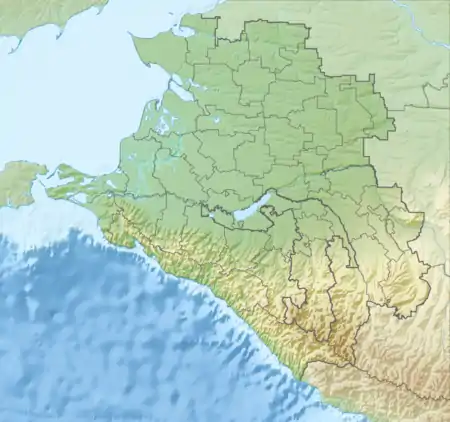Mamkhegh
The Mamkhegh or Mamheg (Adyghe: Мамхыгъ Mamxyġ or Мамхэгъ Mamxeġ; Russian: Мамхеги Mamxegi) are a people of the Adyghe branch of the Circassian people originally from the North Caucasus. Traditionally they lived in the territory between Belaja and Kurdžips Rivers, (territory of modern Majkop and environs in the Russian republics of Adygea and Krasnodar Krai). Due to the Caucasian War, the Mamkheghs were forced to leave their territories in the expulsion of the Circassians and most of the survivors left for the Ottoman Empire. The remaining ones took Russian citizenship and founded a village called Mamxeg, which survives today in the Shovgenovsky District of modern Adygea.
History

The legends say that they moved from Black Sea Coast to the upper territories of Pšexa River. There were three big families first: Shnah, Mami, Tlizhho. When the population significantly increased (natural and immigration from Abadzeh lands) they moved to the territory between Belaja and Kurdžips Rivers, (territory of modern Majkop and environs) where they remained till 1862 and forming about 16 villages. According to authors, the number of Mamkheghs in the middle of the 19th century was about 3,500 people. Yet other sources indicate that they were about 15,000 people.
Aleksandr D′jačkov-Tarasov (А.Н. Дьячков-Тарасов) reported the following Mamkhegh villages in the 19th century:[1]
- Tlevceževy (Тлевцежевы)- on the Kubiok River, a tributary of the White;
- Patukay (Патукай)- six versts from Majkop on the Kuro River;
- Duxxabl′ (Духхабль)- less than a verst from the above on the Kurdžips River;
- Hačemzy (Хачемзий)- on the site of the present village of Tula River;
- Dačehabl′ (Дачехабль)- between Kurdžips and Belaja Rivers;
- Kural′ (Кураль)- central village mamhegov, on the watershed between the Belaja and Kurdžips.
Other villages recorded were: Xoretli (Хоретли), Bardžukaj (Барджукай), Badženaj (Бадженай), Uordane (Уордане), Kujže (Куйже), Tag″anaj (Тагъанай), and Xakunaj (Хакунай).
After a pogrom in 1823, however, the number of villages dramatically decreased as many Mamkheghs sought refuge among Abadzekhs.[2]
Due to the Caucasian War, the Mamkheghs were forced to leave their territories in the expulsion of the Circassians. Most of the survivors left for the Ottoman Empire. The remaining ones took Russian citizenship and founded a village called Mamxeg in the lower part of Fars River (in the Kuban Oblast). Also a big part of remaining people joined various Circassian villages located nearby. In 1884 the total number of Mamkheghs in the Kuban region remaining in Russia composed 1,258 people, 715 of them living in Mamxeg village.
Culture
The Mamkhegh spoke a special dialect of the Adyghe language, closest to that of the Temirgoy, yet in their traditions and lifestyle were the closest to that of the Abadzekh people. According to sources, the Mamkheghs had classes of nobles, freemen, servants and obviously slaves. They, however, did not have the highest class of princes who usually controlled villages, like in most Circassian tribes. The rural administration was in the hands of elected elders from freemen class.
See also
References
- Известия кавказского отдела Русского географического общества, т 14, вып 6, 190 (in Russian)
- Книга «Сокровища культуры Адыгеи» (in Russian)